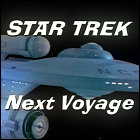 After spending a month writing drafts of the same basic story, Star Trek creator Gene Roddenberry completes the final draft of a live-action script simply titled Star Trek II, though later publications will refer to this script as The God Thing. The script shares many basic structural similarities with the later Star Trek: The Motion Picture, including sweeping upgrades to the Enterprise, Kirk’s promotion out of the captain’s chair, Spock’s return to Vulcan to pursue a purge of his human emotions, and an alien force of unknown power approaching Earth. There, however, the similarities end, as the story depicts an alien entity taking over the minds of Starfleet officers, who begin reciting prayers and exhibiting dangerous degrees of religious zealotry. Kirk and his senior officers, of course, remain unaffected, and disobey the orders of their possessed superiors to save Earth, only to discover that the “God” entity is an alien being which has been influencing human development for thousands of years, having last appeared in a guise which inspired the Judeo-Christian belief system. Likely out of fear of offending its potential audience, The God Thing is swiftly rejected by Paramount, though Bantam Books expresses interest in Roddenberry novelizing his own unused script. Work on that novelization comes to a halt in 1977 as Roddenberry begins work on a prospective Star Trek TV revival, and though other authors will attempt to adapt Roddenberry’s script – including Walter Koenig, Susan Sackett and Fred Bronson, and frequent Trek novelist Michael Jan Friedman – The God Thing remains unpublished. Many elements of the story resurface in Star Trek: The Motion Picture and Star Trek V: The Final Frontier.
After spending a month writing drafts of the same basic story, Star Trek creator Gene Roddenberry completes the final draft of a live-action script simply titled Star Trek II, though later publications will refer to this script as The God Thing. The script shares many basic structural similarities with the later Star Trek: The Motion Picture, including sweeping upgrades to the Enterprise, Kirk’s promotion out of the captain’s chair, Spock’s return to Vulcan to pursue a purge of his human emotions, and an alien force of unknown power approaching Earth. There, however, the similarities end, as the story depicts an alien entity taking over the minds of Starfleet officers, who begin reciting prayers and exhibiting dangerous degrees of religious zealotry. Kirk and his senior officers, of course, remain unaffected, and disobey the orders of their possessed superiors to save Earth, only to discover that the “God” entity is an alien being which has been influencing human development for thousands of years, having last appeared in a guise which inspired the Judeo-Christian belief system. Likely out of fear of offending its potential audience, The God Thing is swiftly rejected by Paramount, though Bantam Books expresses interest in Roddenberry novelizing his own unused script. Work on that novelization comes to a halt in 1977 as Roddenberry begins work on a prospective Star Trek TV revival, and though other authors will attempt to adapt Roddenberry’s script – including Walter Koenig, Susan Sackett and Fred Bronson, and frequent Trek novelist Michael Jan Friedman – The God Thing remains unpublished. Many elements of the story resurface in Star Trek: The Motion Picture and Star Trek V: The Final Frontier.
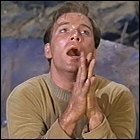 Picked up by the BBC as a summer replacement for Doctor Who, which has just ended its sixth season with the departure of its entire cast, Star Trek begins its run on BBC1 with the episode Where No Man Has Gone Before, the series’ second pilot. Sally Kellerman (M*A*S*H) and Gary Lockwood (2001) guest star. The initial episodes of the series’ UK run are aired in black & white, as BBC1 will not broadcast in color until November 1969.
Picked up by the BBC as a summer replacement for Doctor Who, which has just ended its sixth season with the departure of its entire cast, Star Trek begins its run on BBC1 with the episode Where No Man Has Gone Before, the series’ second pilot. Sally Kellerman (M*A*S*H) and Gary Lockwood (2001) guest star. The initial episodes of the series’ UK run are aired in black & white, as BBC1 will not broadcast in color until November 1969.
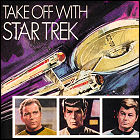 Picked up in syndication by Kaiser Broadcasting’s station group and other independent TV stations across America – often those with no newscast of their own – Star Trek sees its ratings skyrocket. The Kaiser stations run it directly opposite local and network newscasts at 6:00pm in most markets. Paramount Television runs an ad in Broadcast Magazine, claiming that New York City independent station WPIX has shown a 96% gain in ratings over the previous programming in the same time slot. In Los Angeles, KCOP’s nightly Star Trek reruns boost ratings 77%. It is from this culture – the nightly reruns of the 79 episodes reaching saturation point – that Star Trek fandom truly arises, gradually leading to an outcry for new material that gets Paramount’s attention later in the ’70s. With most of the cast battling typecasting, the conventions prove to be a lucrative draw for the show’s stars (and creator Gene Roddenberry, who becomes a popular speaker at conventions).
Picked up in syndication by Kaiser Broadcasting’s station group and other independent TV stations across America – often those with no newscast of their own – Star Trek sees its ratings skyrocket. The Kaiser stations run it directly opposite local and network newscasts at 6:00pm in most markets. Paramount Television runs an ad in Broadcast Magazine, claiming that New York City independent station WPIX has shown a 96% gain in ratings over the previous programming in the same time slot. In Los Angeles, KCOP’s nightly Star Trek reruns boost ratings 77%. It is from this culture – the nightly reruns of the 79 episodes reaching saturation point – that Star Trek fandom truly arises, gradually leading to an outcry for new material that gets Paramount’s attention later in the ’70s. With most of the cast battling typecasting, the conventions prove to be a lucrative draw for the show’s stars (and creator Gene Roddenberry, who becomes a popular speaker at conventions).  A three-day event called Star Trek Lives! gets underway at the Statler Hilton in New York City, organized by a group of fans including Joan Winston and future Star Trek Compendium author Allan Asherman. A gathering of fans in the low hundreds is expected, but instead a crowd of thousands turn up to hear presentations by guest speakers such as Gene and Majel Roddenberry, Isaac Asimov, former Desilu executive Oscar Katz, and Star Trek writer and script editor D.C. Fontana, as well as presentations by guests representing NASA. (Roddenberry will later claim that NBC executives were present as well, though he claims they declined to identify themselves to fans since there was a fair amount of anti-NBC sentiment expressed in the wake of Star Trek’s cancellation.) Though science fiction conventions have been held prior to this event, this is the first dedicated Star Trek convention, and indeed the first such gathering devoted to a single property.
A three-day event called Star Trek Lives! gets underway at the Statler Hilton in New York City, organized by a group of fans including Joan Winston and future Star Trek Compendium author Allan Asherman. A gathering of fans in the low hundreds is expected, but instead a crowd of thousands turn up to hear presentations by guest speakers such as Gene and Majel Roddenberry, Isaac Asimov, former Desilu executive Oscar Katz, and Star Trek writer and script editor D.C. Fontana, as well as presentations by guests representing NASA. (Roddenberry will later claim that NBC executives were present as well, though he claims they declined to identify themselves to fans since there was a fair amount of anti-NBC sentiment expressed in the wake of Star Trek’s cancellation.) Though science fiction conventions have been held prior to this event, this is the first dedicated Star Trek convention, and indeed the first such gathering devoted to a single property.  After years of denying that Star Trek had ever been a “kids show” like its prime-time rival Lost In Space, Gene Roddenberry agrees to NBC’s offer to restart the science fiction cult classic as an animated series, premiering on the seventh anniversary of the live-action show’s debut with the episode
After years of denying that Star Trek had ever been a “kids show” like its prime-time rival Lost In Space, Gene Roddenberry agrees to NBC’s offer to restart the science fiction cult classic as an animated series, premiering on the seventh anniversary of the live-action show’s debut with the episode 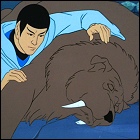 The
The  The
The  The
The 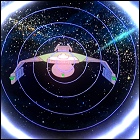 The
The 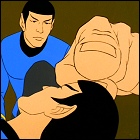 The
The 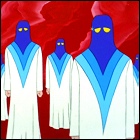 The
The 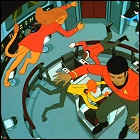 The
The  The
The 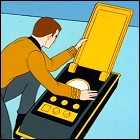 The
The  The
The 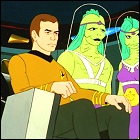 The
The 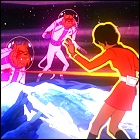 The
The 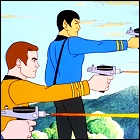 The
The  The
The 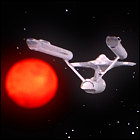 The 275-pound, 18-foot filming “miniature” of the starship Enterprise from Star Trek arrives at the Smithsonian, but it’s just as well that its planned display in the National Air & Space Museum won’t open until
The 275-pound, 18-foot filming “miniature” of the starship Enterprise from Star Trek arrives at the Smithsonian, but it’s just as well that its planned display in the National Air & Space Museum won’t open until  The
The  The
The 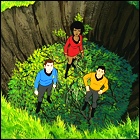 The
The 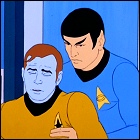 The
The 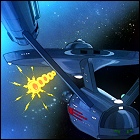 The
The 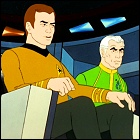 The
The  Future Star Trek: Enterprise co-star Jolene Blalock is born in California. After a career in modeling, she will move into acting, with her role as Enterprise’s resident Vulcan crew member T’Pol standing out as her most recognized work. She will also appear in such TV series as Legend Of The Seeker, G vs. E and Stargate SG-1.
Future Star Trek: Enterprise co-star Jolene Blalock is born in California. After a career in modeling, she will move into acting, with her role as Enterprise’s resident Vulcan crew member T’Pol standing out as her most recognized work. She will also appear in such TV series as Legend Of The Seeker, G vs. E and Stargate SG-1. After spending a month writing drafts of the same basic story, Star Trek creator Gene Roddenberry completes the final draft of a live-action script simply titled Star Trek II, though later publications will refer to this script as The God Thing. The script shares many basic structural similarities with the later Star Trek: The Motion Picture, including sweeping upgrades to the Enterprise, Kirk’s promotion out of the captain’s chair, Spock’s return to Vulcan to pursue a purge of his human emotions, and an alien force of unknown power approaching Earth. There, however, the similarities end, as the story depicts an alien entity taking over the minds of Starfleet officers, who begin reciting prayers and exhibiting dangerous degrees of religious zealotry. Kirk and his senior officers, of course, remain unaffected, and disobey the orders of their possessed superiors to save Earth, only to discover that the “God” entity is an alien being which has been influencing human development for thousands of years, having last appeared in a guise which inspired the Judeo-Christian belief system. Likely out of fear of offending its potential audience, The God Thing is swiftly rejected by Paramount, though Bantam Books expresses interest in Roddenberry novelizing his own unused script. Work on that novelization comes to a halt in 1977 as Roddenberry begins work on a prospective Star Trek TV revival, and though other authors will attempt to adapt Roddenberry’s script – including Walter Koenig, Susan Sackett and Fred Bronson, and frequent Trek novelist Michael Jan Friedman – The God Thing remains unpublished. Many elements of the story resurface in Star Trek: The Motion Picture and Star Trek V: The Final Frontier.
After spending a month writing drafts of the same basic story, Star Trek creator Gene Roddenberry completes the final draft of a live-action script simply titled Star Trek II, though later publications will refer to this script as The God Thing. The script shares many basic structural similarities with the later Star Trek: The Motion Picture, including sweeping upgrades to the Enterprise, Kirk’s promotion out of the captain’s chair, Spock’s return to Vulcan to pursue a purge of his human emotions, and an alien force of unknown power approaching Earth. There, however, the similarities end, as the story depicts an alien entity taking over the minds of Starfleet officers, who begin reciting prayers and exhibiting dangerous degrees of religious zealotry. Kirk and his senior officers, of course, remain unaffected, and disobey the orders of their possessed superiors to save Earth, only to discover that the “God” entity is an alien being which has been influencing human development for thousands of years, having last appeared in a guise which inspired the Judeo-Christian belief system. Likely out of fear of offending its potential audience, The God Thing is swiftly rejected by Paramount, though Bantam Books expresses interest in Roddenberry novelizing his own unused script. Work on that novelization comes to a halt in 1977 as Roddenberry begins work on a prospective Star Trek TV revival, and though other authors will attempt to adapt Roddenberry’s script – including Walter Koenig, Susan Sackett and Fred Bronson, and frequent Trek novelist Michael Jan Friedman – The God Thing remains unpublished. Many elements of the story resurface in Star Trek: The Motion Picture and Star Trek V: The Final Frontier. Ballantine Books releases the Star Trek book
Ballantine Books releases the Star Trek book  Bantam Books publishes
Bantam Books publishes